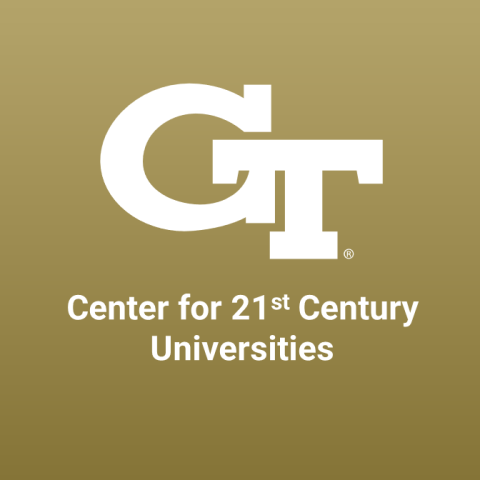
Why transfer student programmes are key to expanding access
With changes to the college admissions landscape and declining applicant pools, it is imperative that US universities think outside the box of standard admissions to find ways to expand access to reach more students from all backgrounds.
The challenges that universities face in seeking to remove barriers and create more pathways for students to pursue a degree include rising costs, lack of uniformity in financial assistance applications and lack of transparency around the expenses shouldered by students and their families. A tactic that I have discussed with Rick Clark, Georgia Tech’s inaugural executive director of strategic student access (see video), is creating pathways for transfer students. Many top institutions are missing an opportunity in not considering transfer programmes as a significant part of their admissions portfolio.
We believe that it is a mistake to overlook this key student demographic. Here’s why:
Transfer pathways attract successful students
College transfers across the US grew 5.3 per cent in the start of fall 2023, according to the National Student Clearing House. Transfers make up 13.2 per cent of the national undergraduate student body, yet many institutions have not altered their enrolment strategies or policies to attract this important cohort of students. At Georgia Tech, more than 20 per cent of our graduating undergraduates did not start their academic career here. Without viable transfer pathways, these talented students from a broad range of backgrounds would not be here, particularly those who were denied first semester admission. And we want them to have another route to our community.
- We need to improve credit portability. Here’s how
- How to attract students who think they cannot afford higher education
- Campus webinar: University admissions: a flawed process?
Georgia Tech offers nine transfer pathways – a comprehensive portfolio of paths of which I’m quite proud. In 2023, 70 per cent of transfer students came in through one of our pathway programmes from 250 colleges across 38 states, representing 38 community colleges and 35 colleges in the state of Georgia.
Last fall, we launched a new transfer pathway collaboration with Atlanta Metropolitan State College (AMSC) that offers AMSC students an avenue to Georgia Tech after their first year of college. The requirements hold these students to high academic standards while also putting resources in place to help prepare them to succeed once they arrive on our campus. For example, we require them to earn at least a 3.3 GPA while at AMSC, receive weekly academic advising and participate in mentoring opportunities.
Students who start at AMSC may not have considered Georgia Tech when originally looking at college options. But we believe that academically driven students who participate in this articulated, cohort-based programme with its mentoring and strong advising structure will thrive once they arrive at Tech.
Transferring can lighten the financial burden
I was a student who worked to pay my own way through my undergraduate degree. While college was certainly more affordable at that time than it is now, I understand and worry about the financial pressures that a student or their family can experience in pursuit of a degree.
One of the best ways we (and other universities) can lighten the financial burden of a degree programme is to provide numerous and flexible transfer pathways for students who, for reasons both personal and financial, didn’t apply to or end up at our university for their first semester or year. It might be cheaper to start college closer to home or students may prefer the flexibility to start in winter, for example, rather than autumn.
I think Rick said it well in our conversation: “True talent is evenly distributed, but opportunity is not.” I see great benefits in having many avenues that students can take to access an education (whether that be physical or virtual). Making a top-ranked education more accessible through non-traditional pathways is important to expanding who has access to higher education.
College is expensive in the US and a transfer pathway can help lighten that burden.
Transfer students can and will succeed
It is our experience that students with non-traditional paths to a college degree, whether it be transfer or online students, can achieve great things. Transfer students make up more than a quarter of our undergraduate population. Our four-year graduation rate is 70 per cent (the national average is 64 per cent) and our six-year rate is 94 per cent.
We believe that now is the time for universities to look at how they might better establish transfer and other non-traditional student pipelines, consider their future enrolment strategy (particularly in light of shrinking domestic high-school graduation rates) and closely assess institutional data to better understand transfer student success.
Fundamentally, transfer pathways are a strategic way for universities to bolster enrolment and broaden access. In a time when students need and want flexible, affordable options, it is imperative that universities adapt and create avenues for this brilliant, often overlooked talent pool of students. We hope to see more peer institutions embrace this thinking and work alongside us to expand access to a top-quality education for the next generation of students.
Steve McLaughlin is provost and executive vice-president for academic affairs at the Georgia Institute of Technology.
If you would like advice and insight from academics and university staff delivered direct to your inbox each week, sign up for the Campus newsletter.
Key Details
This video will cover:
00:33 What does the role of executive director for strategic student access involve?
02:19 Cost transparency for students and families
06:36 Why universities need student transfer programmes
Transcript
Steve McLaughlin: I’m Steve McLaughlin. I’m the provost and executive vice-president for academic affairs here at Georgia Tech, and today I’m with Rick Clark, our executive director for strategic student access. And we’re here to talk about student access and attracting all kinds of students, from all kinds of places, to Georgia Tech and to universities like us. So welcome, Rick.
Rick Clark: Thanks so much for having me and looking forward to the conversation.
SM: Just the title of your new role, strategic student access, you touched just really briefly on other states and so on, but I think it’s a breakout role.
RC: Yeah.
SM: Meaning you’re the first, maybe nationally, to hold that role. What are you hearing from other people? The success stories? Is it a model?
RC: People ask me now: “What are you doing? What’s this role, exactly?” And the way I kind of describe it as I’m sort of in a triangle between our larger, big, strategic initiatives that you and the president, the cabinet, ELT and others are setting out, development and thinking about how are we raising dollars to offset the rising cost of college and the rising cost of Georgia Tech, and then enrolment. So that triangle is just so critically important, not just for Georgia Tech and all of our big bets and strategic plans to come to fruition, but really if you look around the country, I mean that is the lifeblood of higher education, tuition dollars and ensuring you have viable enrolment, private dollars and logical, strategic partnerships with organisations and corporations, I mean, so tying those together, the strategy and the vision of the future that you guys set forth, the enrolment of why it’s compelling and important for students to come to our institution, and the dollars to make that reasonable. So, I have gotten calls from private schools, public schools, every size you can imagine, asking: “Can we see the job description? How did you guys come up with that? How’s that really working? What would, you know, change or advise going forward? I think it actually is, yes, the first and an inaugural one here, but probably in many ways a model that schools will be looking to in the future.
SM: If you had a magic wand to say nationally or even to our state, do you have one or two things that you wish could happen that would really unlock student access, the very, very top students who don’t feel like they have access to but we're saying they do?
RC: Sure.
SM: Do you have one or two things that if you were president for a day, what would you do?
RC: Well, if I were over all of higher ed, if there was a grand poobah or a chancellor of the entire higher education system, I think one of the biggest things we can do in our country that’s necessary is more cost transparency. You know, if you look at financial aid letters from one school to the next, it is not apples to apples. The way that schools describe their cost and how much a family’s really going to have to take out in loans is at best confusing and sometimes, at worst, slightly nefarious. And I do think if I could wave a magic wand, a realistic magic wand, instead of just saying all college is free, a realistic magic wand to say we owe it to the public to make our costs more transparent. And the more uniformity between language, the more uniformity between format for families, ethically I think it’s the right thing to do and it would lead to more equity in access for various students and families.
SM: Can you share a little bit more about what really is the challenge that the universities face? We know what the challenge parents and students face. What are the challenges the universities face?
RC: Sure. Well, first of all, cost of college has gone up, and on the ground for families, they feel that, but there’s a reason that that’s occurred for universities. Some of this has been way outside of our control, in terms of some of the necessary accommodations that we’ve needed to make, some of the services that everybody wants us to provide, in terms of real estate cost and housing and auxiliary services, cost has just simply gone up for universities. And you know here in Georgia, as just an example, we have a great exemplary programme called Hope and Zell Miller scholarship, right, funded by the lottery and that covers tuition. And I think a lot of people hear that and think:
SM: “It’s free.”
RC: “Hey, it’s free.” But it’s not free and the truth is that over the last decade what was extra cost beyond tuition, at about $8,000, [is] now approaching nearly $20,000, and so for a family who has means, that’s sounding great relative to the rest of higher education. For a family who’s maybe just your average earning family, at about $75,000, $20,000 a year is a really tough pill to swallow. And so what we, universities, and we, Georgia Tech, are trying to address is how can we offset those costs? What can we do to ensure that any talented student has the ability to come to Georgia Tech and not walk out with a lot of debt?
SM: I think in terms of myth busters and I bet you there are some myths that the public hold about these students.
RC: Sure.
SM: About where they come from, what ethnic groups they come from, what parts of the state they come from.
RC: Yeah.
SM: Do you have any myth busters you want to kind of throw out there, so that the public can really understand both the magnitude and to whom does this problem, the limited income problem, apply?
RC: It applies evenly across every demographic you can name. It is gender agnostic. It is ethnicity agnostic. You know, it’s rural, it’s metro. It’s really everywhere. And I will say that’s one of the reasons why I’m thankful to have the opportunity to work in this space is because I’ve had the opportunity over the last two decades to travel all throughout our state and really all throughout the country and, through my work with the State Department, throughout the world to see this idea. And it is so true – talent is evenly distributed, but opportunity is not. It is incredibly inequitable. And so what Georgia Tech’s trying to work into that space on is to say we need to go and to be there, regardless of a student’s colour, regardless of a student’s gender, regardless of a student’s academic aspirations, and provide opportunity and vision. Ultimately, I think that’s really what, you know, higher education’s all about is opening doors and opening, you know, your eyes to more.
SM: One of my favourite hot-button places that we spend a lot of time on is in transfer programmes.
RC: Yeah.
SM: And I kind of want to talk about how so many of the top institutions don’t see transfer programmes as part of their portfolio.
RC: Right.
SM: A lot of the privates don’t see transfer programmes as their portfolio. Publics maybe more so.
RC: Sure.
SM: Can you talk to students…
RC: Yeah.
SM: …about being, and parents, to use transfer programmes as a way of saving money?
RC: As schools think about the future, whether you are the most well-endowed, well-respected, internationally known school or not, transfer should be part of the plan. It’s just sort of logical from an enrolment standpoint. But why transfer for a student? You know, I really think flexibility is the future from a student standpoint. And, to your point, that could be because of the economics of it. It could just be less expensive to start closer to home, at a regional public university, at a community college, and then transfer in, to Georgia Tech or somewhere else. Also, the idea that it doesn’t have to always be fall, and we’re starting students in Europe in the summer. We’re starting students, a really new initiative, at a local partner institution here in the Atlanta metro area to then come in after a year. So, this idea of pathways and flexibility and different paths into the ultimate same degree, I think just makes a lot of sense, not only for us but really for most of higher education.
SM: Well, thanks for being here, Rick. Really, really, really appreciate everything that you’re doing for students and the family and just to see the energy that you bring to the role and the impact that it’s going to have for so many students, I just want to thank you for everything you’re doing and for being here.
RC: Thank you.



